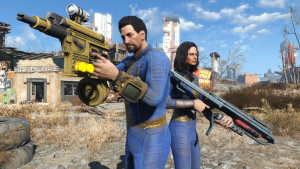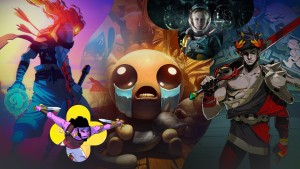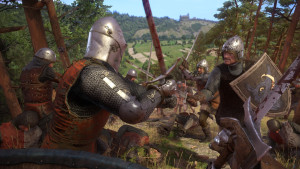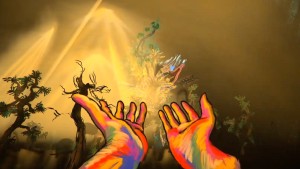Please support Game Informer. Print magazine subscriptions are less than $2 per issue
Fall Of The Empire: How Inner Turmoil Brought Down LucasArts
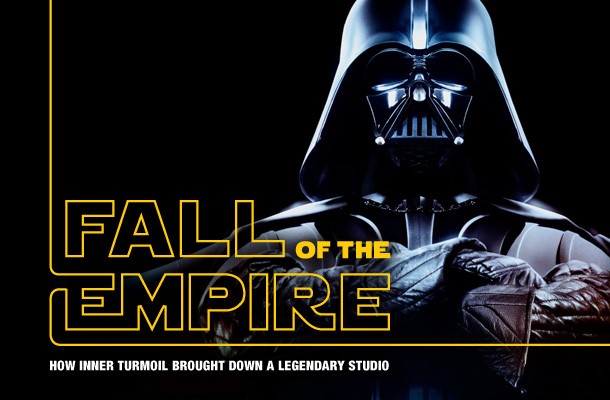
[This feature originally appeared in Game Informer issue #250]
Like a farm boy looking contemplatively upon two suns, in 2004 LucasArts was searching for answers and ways to right a video game business in disarray. Although Star Wars fans were pleased with several of the studio’s latest endeavors with the license – namely BioWare’s Knights of the Old Republic and Raven Software’s Jedi Academy – George Lucas felt that his beloved galaxy was tapped for far too many mediocre games. Even the popular titles weren’t generating the revenue needed to sustain a healthy business model.
Lucas entrusted the future of the company to newly appointed president Jim Ward, who previously held the position of Lucasfilm’s senior vice president of marketing, global distributions, and online for seven years. During his tenure at Lucasfilm, Ward was a key player in Star Wars: The Phantom Menace’s media blitz, which raked in over $400 million in the box office despite its poor critical reception. He also helped guide Star Wars: Attack of the Clones to a successful run on the silver screen.
Ward didn’t waste much time altering LucasArts’ battle plans. In a press release he stated, “To make LucasArts thrive and to position ourselves for the long-term future, we need to make some fundamental changes.” The new focus led to the slimming of LucasArts’ workforce from roughly 450 employees to 190*, and a shift in development for internal and external studios.
Months after taking his new position in gaming, Ward told Game Informer, “Five years from now, I want to have been able to put the ‘Lucas’ back in LucasArts. To have that same ‘pixie dust’ feeling when people see that logo that they maybe did in the ‘90s. For them to think, ‘If I pick up this game, I know it’s going to be kick ass; I know it’s going to be of the highest quality and the most creative thing out there.’”
That sentiment was echoed by gamers and critics alike late in 2004 after they played Pandemic Studios’ Star Wars: Battlefront, a multiplayer-focused shooter that capitalized on the immense scale of this universe’s wars and vehicles. The game was backed by an impressive marketing campaign that coordinated its release on the same day as the reissue of Star Wars’ original trilogy on DVD. This move, masterminded by Ward, created a huge Star Wars event at retail.
In 2005, LucasArts’ portfolio of releases consisted of just five titles, yet, according to NPD data, the company’s sales ranking rose to eighth, up from thirteenth in the previous year. Out of the top ten selling games that year, Star Wars: Battlefront II ranked sixth, and Star Wars: Revenge of the Sith held the eighth slot. The other titles – Mercenaries: Playground of Destruction, Lego Star Wars (published by Eidos), and Star Wars: Republic Commando – all sold well.
From a numbers standpoint, LucasArts seemed like it was well on its way to becoming a publishing powerhouse. Ward’s hope was that LucasArts would be a top-five publisher by 2008.
Behind the scenes, however, all was not well. Numerous LucasArts employees, all who wish to remain anonymous, recall the company spiraling out of control during this prosperous time.
“Jim Ward’s leadership style was not for everybody,” one source says. “He was a challenging person to get to understand. He came from the film side. His objective was nothing less than changing the way the entire industry worked by the sheer force of his own will. He was quoted several times basically saying, ‘I don’t understand why video games can be late. When Industrial Light and Magic works on Harry Potter, they don’t have a choice to be late. The movie’s going to open. The effects have to be done. You don’t get it. There’s no choice. So I don’t understand why we get in this situation where games can be late.’ It turned out that he couldn’t change the way the industry worked in the way he desired. But he was the type of guy who wouldn’t take, ‘That’s just how it’s done’ for an answer.”
Another LucasArts employee remembers a particularly divisive decision made by executives for Star Wars: Battlefront II, a game that was already in danger of quality issues due to LucasArts only giving it one year of development time. “It was originally being designed as a multiplayer-only game,” this staffer recalls. “It remained that way for most of its development cycle. New people who came in after the game was in development basically said, ‘No, we’re not going to make money off of a multiplayer-only game, you have to put in a single-player campaign.’ Pandemic screamed bloody murder and said it couldn’t be done, but [LucasArts] said that they had to figure it out. Battlefront II’s producer at LucasArts basically had a breakdown bringing the game in, but the team made their deadlines and the game sold like crazy. It was probably a bad lesson for Ward to learn, because LucasArts was successful at doing something that everyone thought was impossible.”
When a development team would reach a milestone, a “core meeting” would be assembled on LucasArts’ campus, consisting of roughly 40 to 50 people spread across development, marketing, management, public relations, quality assurance, business development, among others. Ward and LucasArts’ top brass conducted these meetings, which played out like show-and-tells where developers would detail the progress made to their projects.
“Those are the infamous ‘Jim Ward losing his s---’ meetings,” a former employee remembers. “If you were sitting at the table, it meant you were in the firing line for any number of crazy business questions. People would arrive at the meeting early and sit around the perimeter of the room. If you got there a couple minutes before the meeting started, and only table seats were left, you were like, ‘F---!’
“It would be the type of thing where a team would show a build and [Ward] would say something like, ‘Alright, [Quality Assurance], based on the playthroughs what are we rating this right now?’ And it would be a 22-year-old QA person who showed up late and was sitting at the table that answered. He would say something like, ‘84,’ and Jim would say, ‘That’s not good enough. What gets this game to a 90?’ QA would nervously say, ‘Oh, adding online co-op,’ which is not at all in the schedule or budget, and Jim would say, ‘Let’s look into that.’ The dev team wouldn’t know how to respond to that. That addition wasn’t in the books. We became this forum for democratization, but nobody really had any idea of what was going on. At the same time, nobody wanted to tell the truth, because they didn’t want Jim to lose it and fire a water bottle across the room.”
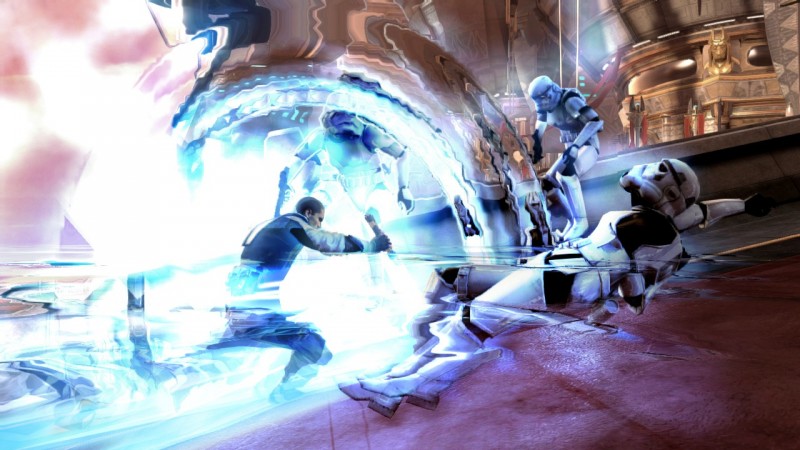
CREATIVE DIFFERENCES
In 2006, LucasArts teamed with Day 1 Studios to bring a new intellectual property to market. The vision for this new title was a first-person shooter that allowed the player to shape a battlefield’s terrain by using various science-fiction weapons. That ambitious design became Fracture, a game that was announced on May 3, 2007.
“The plan [for Fracture] was turned completely upside down in a meeting,” a LucasArts dev who worked on the title says. Although the team was far into development, a decision was made by LucasArts’ executives to turn it into a third-person shooter. “We were told to ‘pull the camera out.’ We had to make a character model, create animations, plot the levels differently, stream it differently. It was a nightmare for everyone involved.”
When Fracture was revealed to the public, its protagonist was a character named Mason Briggs. By the time the game launched, his name was changed to Jet Brody. A person who helped give this gun-toting rebel his original name recalls going through weeks of naming conventions. “Literally, whole teams sitting together, brainstorming what looks good – the first name, the last name, etc. Done, good to go.”
But then a phantom menace struck. George Lucas would periodically check in on the status of the games his company was making, lending creative input and advice. The developer I talked to sighs, and agitatedly says, “In one viewing of Fracture, [Lucas] said it looked really good, but he didn’t like [Mason Briggs’] name. We’re like, ‘What do you mean, George?’ He responded to the effect of, ‘It doesn’t really fit. When he jumps on stuff, he moves pretty fast. I like B.J. Dart.’
“So everybody’s like, ‘No, he’s gotta be f---ing with us.’ He’s absolutely not. So when something like that happened – in the middle of the campaign, mind you – we have to go back through that entire naming convention again… from scratch.” From that second session, Jet Brody was born. Coincidentally. Jett is the name of Lucas’ son.
A similar situation arose with Star Wars: The Force Unleashed’s protagonist, Starkiller. “[That name] was only supposed to be a nickname or call sign, not a proper name from the beginning,” a former LucasArts employee says. The development team hoped that Lucas would give Vader’s apprentice a Darth moniker, which at the time, was something that didn’t happen often.
“The team threw a Hail Mary to George, saying the game would have more credibility if the apprentice had a ‘Darth’ title,” a Force Unleashed team member says. Lucas agreed that this situation made sense for Sith royalty, and offered up two Darth titles for the team to choose from. “He threw out ‘Darth Icky’ and ‘Darth Insanius.’ There was a pregnant pause in the room after that. People waiting for George to say ‘just kidding,’ but it never comes, and he just moved on to another point.”
Team members involved in the decision to not use these ridiculous Darth titles could not be reached for comment, but three LucasArts employees believe an excuse was made to push the Darth title to the sequel. By the time development on that title commenced, the names were long forgotten by Lucas and weren’t muttered by the development team again. Starkiller remained Starkiller in the games, but was also named Galen Marek in the greater Expanded Universe fiction.
“These name problems may sound like funny stories, but the quality of these games suffered from these curveballs thrown by people not directly tied to the development process,” another employee angrily adds. “It got to a point that it became difficult to hire new talent because these stories got out there. People thought we were running a madhouse.”
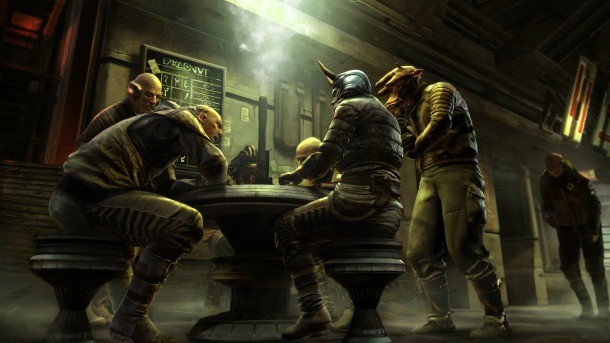
WHAT COULD HAVE BEEN
In 2006, LucasArts’ internal development structure consisted of three teams, one working on Force Unleashed, another on Indiana Jones, and a third called “Team Three.”
A LucasArts employee remembers the third studio being in a state of constant flux. “They had this interesting, tortured history where there was an effort for them to create a full-fledged game, but they could never get anything greenlit for various reasons. Ideas went all the way up to Lucas, and he didn’t approve them, or ideas never made it to him. The team was recast to become the handheld division. They came up with quite a few concepts, five or six different ideas that could be DS games, but none of them got off the ground, either.”
Numerous LucasArts personnel provided details for some of these projects. One was a platformer starring a furry woodland creature scampering around and going on adventures. Another pitch was for a crime-solving game in which the player was a detective with the ability to examine photographs from within their proofs. One concept that gained traction and entered development before being scrapped was a downloadable shooter titled Caveland.
LucasArts’ push for more internally developed Star Wars titles left behind a tantalizing trail of unreleased projects. Star Wars: Imperial Commando, a sequel to Republic Commando, would have put the player in control of an Imperial assault team, but never made it out of the conceptual phase of development. Star Wars: Knights of the Old Republic III was almost greenlit, but none of the people I talked to involved in the project knew why it was canceled. “Most of the conceptual and story groundwork for the title was there,” a LucasArts employee says. Star Wars: Jedi Knight III – Brink of Darkness and Jedi Master were two different directions LucasArts hoped to take its Jedi Knight series, but neither made it to proper development. Other scrapped Star Wars titles included Smuggler, a linear action game that focused on a Han Solo-like character; Rebel Warrior, a violent action game with a Wookiee protagonist fighting the Empire; a title that put players into the role of Darth Maul called Star Wars: Darth Maul; an internally developed Star Wars MMORPG codenamed Proteus; a Call of Duty-like shooter named Star Wars: First Assault; and most surprisingly, Star Wars: Episode VII – Shadows of the Sith, which was believed to be a spin-off to the upcoming motion picture now helmed by J. J. Abrams.
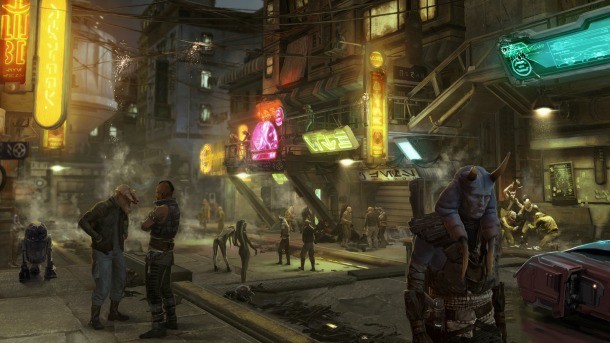
A TROUBLED PARTNERSHIP
Then there was Star Wars: Battlefront III, a project LucasArts entrusted to developer Free Radical, of TimeSplitters fame. Industry veteran and Free Radical founder David Doak remembers the excitement that was in the air when LucasArts pitched his team. “We were looked at like reliable hands for making shooters,” he says. “We had never done the work-for-hire thing before, and we always wanted to make our own thing. However, we could see that there was a lot of uncertainty in the industry. It’s like, ‘Well okay, that sounds like a good opportunity.’”
Free Radical pitched an ambitious design to LucasArts, in which the game would seamlessly transition from running and gunning on the ground to flying a vessel into space, where another war was being waged. “Within that, the seeds for disaster were sewn,” Doak says. “I think that core design pillar of the game was slightly untenable because of the scale.”
Free Radical worked on the Battlefront franchise for over two years, trying to get its vision to work. The art team moved on to designing assets for Battlefront IV even while Battlefront III was struggling to reach its intended vision.
Red flags were waved internally at Free Radical, but on LucasArts’ end, the game was looking like a smash hit. Development on Battlefront III seemed to be going well. “We kept getting these code drops that were amazing,” an ex-LucasArts employee remembers. “The big hook of going from ground to air to space seamlessly totally worked. Piloting a capital ship, getting out and running around in the ship’s interior, and jumping into an escape pod and rocketing down to land again – holy s---! We thought [Battlefront III] was going to turn the industry on its head. Free Radical was meeting all of their milestones. Even Jim Ward would sit in those core team meetings and would say things like, ‘So this is shipping next month, right?’ And this was 2007. This is a joke because it was looking so good, especially compared to Fracture and Force Unleashed at the time, which were just troubled the whole way. And we would all laugh, thinking, ‘Wow. If it looks this good now for a game that’s shipping in 2008, there’s not going to be any problem.’”
Difficulties arose early in 2008. Free Radical started missing milestones, and the new builds of the game that were coming in featured major stability issues. The design called for 100-player multiplayer matches. “We’d get 20 players in a match and it would just bog down,” a source close to the project says. “Then Free Radical started cutting content. They’re like, ‘Ok, we’re going to go from 100 to 50 players online. That’s still really good; it’s still more than anyone else. That’s fine. We’re going to cut this single-player campaign down in scope.’ So then the cuts started coming, which is all fairly standard stuff. But we just couldn’t get an estimate. It was starting to become apparent that they weren’t going to make the [release] date that they said they were going to make, and they weren’t being very clear about why or what the new dates would be. Internally, because this was right when Haze was shipping, we were all certain that they had pulled tons of resources off Battlefront to finish up Haze, and they wouldn’t tell us what was going on. We tried to get our producers over there and they wouldn’t let us into the building. The relationship just started fraying.”
At that time, Jim Ward stepped down as LucasArts’ president and was replaced by Darrell Rodriguez, a new overseer who a former associate sized up as “not f---ing around.” Rodriguez pushed Free Radical hard, creating a tense working relationship between the two companies.
Doak recalls this time, his words quiet and melancholy. “I wouldn’t even talk about it personally because it completely did my head in,” he says. “I think, particularly, because of the role that I was creative director and also the front man for the company, I got to do all of the putting on a brave face and smiling, then going behind doors and having the arguments, and then going back telling my guys we have to work harder this time. And after that thinking, ‘You’re going to miss the next milestone because I know they [LucasArts] don’t want you to pass it.’ I really hated that. It just completely stopped me from functioning. You don’t believe it’s actually a real thing until it happens to you, but I was in the midst of a nervous breakdown. Tears all over the place. It was just a really horrible time. I wasn’t there for the very end.”
In an interview with Eurogamer, Free Radical audio director Graeme Norgate revealed that LucasArts stopped funding the project around this time.
“LucasArts hadn’t paid us for six months, and were refusing to pass a milestone so we would limp along until the money finally ran out,” he said. “They knew what they were doing.”
In early 2009, Free Radical released a company video that made fun of LucasArts and Star Wars. In it, a representative of LucasArts tells a Free Radical employee, “We have to pull the game. It has become too good. You need to make it worse, or we are pulling the game. We need to make products with the Star Wars name, but with little content. It’s about making a f---ing bucket full of money, don’t you understand?” After an exchange of words, the Free Radical employee responds, “You guys are a--holes.”
“We sent Free Radical an email asking for them to remove [the video], and they refused to take it down,” a former LucasArts employee says. “That was one of the last straws for Darrell.”
Ties with Free Radical were severed, but the fate of Battlefront didn’t remain in limbo for long. LucasArts’ creative lead/creative director Adam Orth teamed with former SOCOM developer Slant Six to create a new vision for a Battlefront sequel.
The disastrous Free Radical relationship had a profound effect on LucasArts’ business moving forward, an ex-LucasArts staffer remembers. “At that time, the idea was to make [Slant Six’s] Battlefront III downloadable-only. You could not push through a new major console project at LucasArts at that time. There was no appetite for it. Even as early as 2009, the powers that be at Lucasfilm would not agree with that kind of expenditure. I think the board at Lucas had just lost their stomach for the risk there.” Slant Six’s Battlefront eventually met the same fate as Free Radical’s.
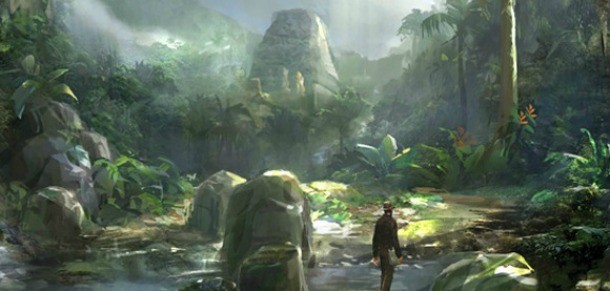
A NEW ERA DAWNING?
While many of LucasArts’ projects derailed in the development stages, the company did release its most successful title during this time. The Force Unleashed flew off store shelves, becoming the fastest-selling Star Wars game to date, with over seven million copies in circulation.
LucasArts’ goal was to release both Indiana Jones and Force Unleashed in 2007, but setbacks in development for both titles altered these plans dramatically. “[It] was an impossible goal,” a former LucasArts developer remembers. “We saw there was no way that was going to happen, but the company was very energized. They were hiring like crazy.” The goal was to staff up both teams to over 100 each, but the company couldn’t bring in quality talent fast enough, especially engineers with PS3 experience.
If a LucasArts employee brought in a new hire, they were rewarded with an Xbox 360, and if that new recruit stayed with the company for over six months, a substantial monetary bonus.
Half of the Indiana Jones team moved over to Force Unleashed, prioritizing this title for a 2007 release and pushing Indiana Jones into 2008. Even with a fully staffed team, development ran into problems, pushing it well outside of the 2007 release window. At that time, most new employees were added to the Force Unleashed team. Indiana Jones’ development continued on, but with a skeletal team not large enough to make legitimate progress on the title. The scale of the Indiana Jones game was ambitious, showcasing impressive technology and what one developer remembers as “ambitious water physics.”
A big blow to Dr. Jones’ video game return came from an outside source. That year, Naughty Dog and Sony Computer Entertainment released a game called Uncharted. One LucasArts employee remembers that day well, as a large group of Indiana Jones’ developers gathered in a demo room to check out Naughty Dog’s work. “I have never seen a more f---ing forlorn group of guys, because that is exactly the game they were trying to make,” this staffer says. “Indiana Jones had a cistern level – same as in Uncharted – it had similar jungle environments, too, but one of the big things that they were attempting were those run-for-your-life moments, where something happens, the camera turns, you have a different perspective that shows the danger behind you, and then you have to control the character out of it – which is exactly what Uncharted did. They had effectively out-Indy’ed Indy.”
When Rodriguez joined the company, he looked at the progress (or lack thereof) made to Indy’s adventure, and decided to shelve the PlayStation 3 and Xbox 360 versions indefinitely. Only the subpar Wii version, which was named Indiana Jones and the Staff of Kings, saw the light of day.
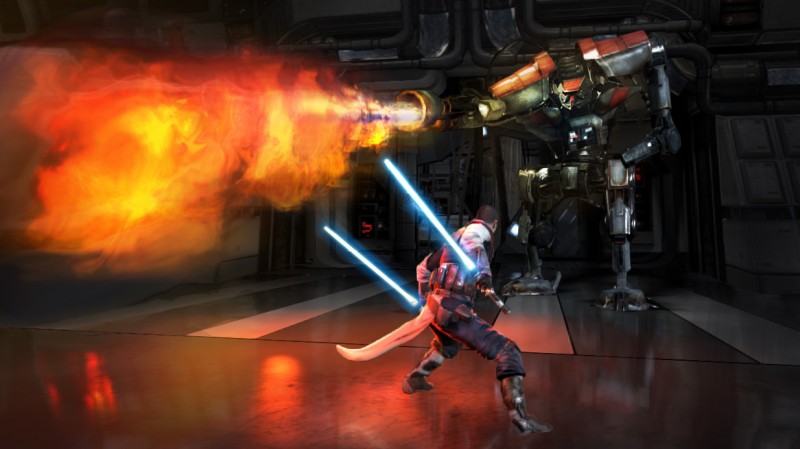
SLOWING TO A CRAWL
Although Force Unleashed was a huge hit for the company, the sequel wasn’t greenlit right away. The development team worked on concepts for a sequel for close to a year, and created various demos showcasing new ideas – one of which was Starkiller using two lightsabers. In one meeting in 2009, Lucasfilm asked that the sequel be made in a year, despite the development team saying they would need two. “The team’s response was, ‘If that’s all we get, it’s going to be six hours long and will probably score a 60,” an employee remembers. The Metacritic review score average for The Force Unleashed II was 61. The game didn’t flop at retail, but it also wasn’t a mega-hit like its predecessor.
Force Unleashed II was the only game released by LucasArts in 2010. Layoffs rippled throughout the company. Rodriquez stepped down as LucasArts’ president, and was replaced by Paul Meegan.
Far removed from LucasArts’ intimate game development procedures, BioWare was quietly working on a new Star Wars MMO. Even today, rumors continue to swirl throughout the video game industry that BioWare and Electronic Arts’ Star Wars: The Old Republic is one of the most expensive games ever created. In a 2011 story, the New York Times reported that it might have cost between $125 and $200 million to make.
LucasArts’ expenses for this project were reportedly minimal. An employee who worked on the game says this is one of the smartest partnerships the company ever made. “For all the dumb things they did, they also did some super smart things,” he says. “The deal [LucasArts] made was that BioWare was going to fund every dime for The Old Republic. Lucas ended up funding the voice work, but BioWare and EA fronted most of the bill. LucasArts just made money off of the backend. [The Old Republic] wasn’t as successful as anyone wanted, but that team at BioWare was amazing. They made a really big, risky game. And the whole way, were totally dedicated to it.” LucasArts’ executives presented a video of the deal being signed to the entire company. The deal itself was held within a thick binder.
BioWare’s work on The Old Republic reportedly started way back in 2006 (the game didn’t release until December 20, 2011). In an internal greenlit document that Game Informer secured, the initial plan for The Old Republic was for the gold master to be completed on September 30, 2009. The first high-level milestone was due on April 30, 2007. Numerous LucasArts employees wished that more deals similar to BioWare’s would have been made, free of their company’s tinkering.
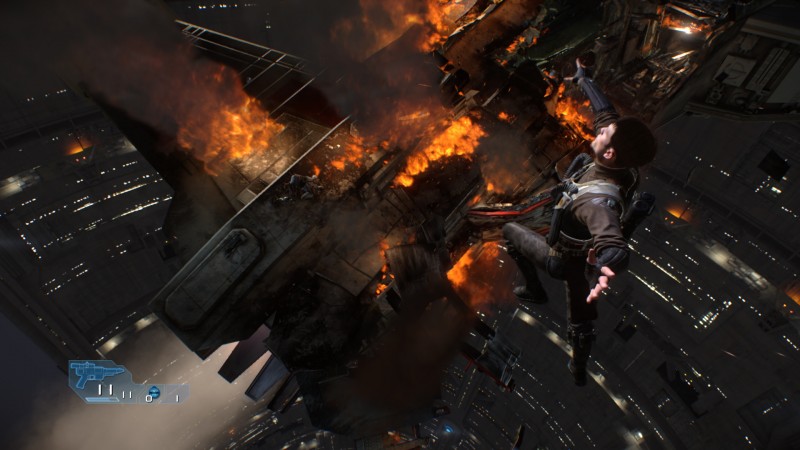
END OF AN ERA
From 2011 to early 2013, LucasArts’ catalogue of games remained slim, consisting of just Lego Star Wars III: The Clone Wars, Angry Birds Star Wars, Kinect Star Wars, and The Old Republic. LucasArts’ internal development push couldn’t find stable footing.
While Lucasfilm pushed LucasArts to support the Clone Wars animated series with numerous products, a big shift came with a surprising internal announcement.
Plans were in motion for Lucasfilm to create a live-action TV series called Star Wars: Underworld, a source says. LucasArts was tasked to build a tie-in video game. Excitement rippled throughout the studio, and a game design came together quickly, calling for an open world that favored vast exploration and RPG elements. “Those plans didn’t last long,” the source adds. “LucasArts’ executives decided to change direction to a vanilla shooter – because that’s what was selling then. Shortly after that, we thought the project was destined for cancellation because the TV show hit development hell.”
The project moved on slowly until George Lucas became heavily involved with its direction, much to the initial delight and eventual ire of the team. They embraced his idea to make the protagonist a new bounty hunter, but often had their work derailed by Lucas suddenly changing his mind or demanding significant alterations to the script and the game’s tone.
One of Lucas’ most crushing curveballs came weeks before the game was announced. He didn’t want the protagonist to be a fresh face; he wanted it to be Boba Fett. Without any working Boba Fett assets ready for the announcement, the team members who unveiled the project to the press during 2012’s Electronic Entertainment Expo, had to play dumb. They lied when asked directly about it, unable to mention anything about the iconic bounty hunter being the lead.
The new direction for the game brought the title change of Star Wars: 1313, a name which Star Wars fans immediately connected to Boba Fett since he used the alias CT-1313 in the novel Boba Fett: Maze of Deception. The game was well received at E3, drawing many comparisons to the Uncharted series, the same franchise that essentially landed the killing blow on Indiana Jones.
The atmosphere at LucasArts was completely different after that reveal, a source remembers: “We were all really happy and driven to make Star Wars: 1313 the best Star Wars game yet. It was fun seeing fans gush about it. It was also fun showing the world their first next-gen game. We got in a lot of trouble for that.”
Although LucasArts wouldn’t confirm what platforms Star Wars: 1313 was destined to release on, the graphical fidelity in the demo showed it was obviously being designed for PC, PlayStation 4, and Xbox One. Work on the project continued as planned.
In August 2012, Meegan stepped down as president, and Kevin Parker and Gio Corsi were brought in to co-lead the studio. Another assessment of the company’s business brought hiring freezes and internal strife. 1313’s development was crippled from the lack of new staff needed to hit milestones. LucasArts fell into silence.
Then, everything changed.
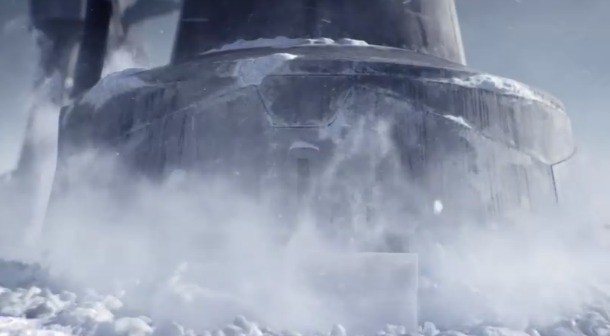
A NEW BEGINNING
On October 30, 2012, Disney announced it purchased Lucasfilm and LucasArts. Bob Iger, chairman and CEO of Disney, added to the excitement when he revealed that Disney was, “planning to release Star Wars: Episode VII – the first feature film under the ‘Disney-Lucasfilm’ brand. That will be followed by Episodes VIII and IX – and our long term plan is to release a new Star Wars feature film every two to three years.”
From this unexpected partnership with Disney, a new hope was restored to LucasArts. With an entirely new Star Wars era to explore and Disney lording over the company’s operations, many video game pundits – Game Informer included – believed LucasArts would be stronger after this merger. At the time, Iger said Disney wanted to focus on social and mobile experiences over console titles, but we didn’t anticipate what happened next.
On April 3, 2013, Disney announced it was closing LucasArts. An official statement released by Disney read: “After evaluating our position in the games market, we’ve decided to shift LucasArts from an internal development to a licensing model, minimizing the company’s risk while achieving a broader portfolio of quality Star Wars games. As a result of this change, we’ve had layoffs across the organization. We are incredibly appreciative and proud of the talented teams who have been developing our new titles.”
Work on 1313 and all other internal projects (Star Wars: First Assault included) were put on indefinite hold. The last game published by LucasArts was Kinect Star Wars.
While the LucasArts we knew is gone, the company’s name will live on under Disney’s guidance as a publishing division. The first fruits of this new deal are already being seen in mobile games like Star Wars: Tiny Death Star. Disney also partnered with Electronic Arts to exclusively bring Star Wars games to PC and console.
At this past E3, Electronic Arts revealed that a new Star Wars: Battlefront title was in development at DICE. Visceral and BioWare are also working on Star Wars projects.
LucasArts left behind a rich history of games. From Ron Gilbert and Tim Schafer’s excellent adventure titles to an impressive portfolio bearing the Star Wars name, this studio had no shortage of hits in its 31-year history. Though the company was struck down by its own failings and the pitfalls of the modern game industry, the legacy of its work will live on in the memories of gamers.
*from Rob Smith’s book, Rogue Leaders: A History of LucasArts
**Jim Ward, Lucasfilm, and executives from both teams could not be reached for comment

